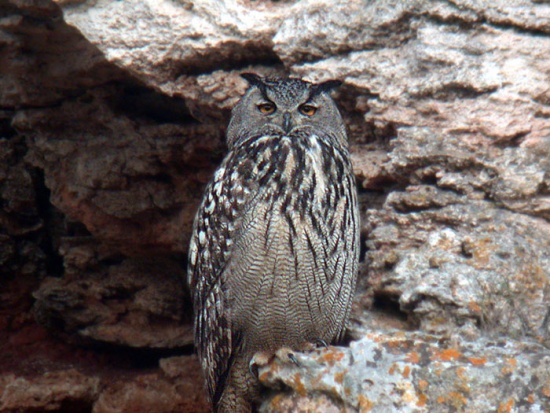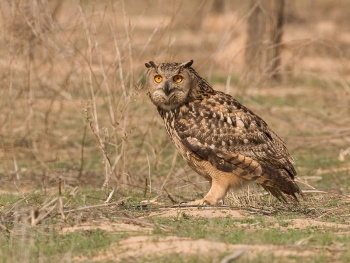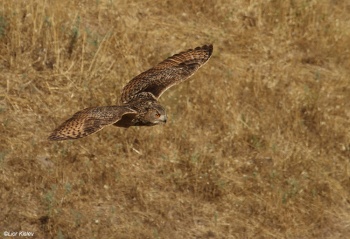Alternative name: Great Eagle-Owl
- Bubo bubo
Identification
Largest European Owl at 65-70cm (a little larger than Common Buzzard).
Adults: brown upperparts with blark markings including both streaks and bars in a somewhat irregular pattern. Underparts are clearly paler than upperparts, but have black streaks mainly on breast while belly has pattern of black feather shafts and cross-bars. Large, orange eyes appear in a facial disk that is greyish-brown to buff, bordered dark but with somewhat inconspicuous border. Eye-bows are pale stretching from above the eye to below the eye and running between the eye and the bill. The overall effect can be quite fierce-looking. Prominent wide ear tufts varying between pointed sideways or up and only disappearing in flight. Bill and claws black. Legs are fully feathered. Bright patch on outer wing visible in flight.
Variation
Basic color differs quite a lot through the huge range, from tawny to blackish to buff on upperside and to almost whitish or greyish-brown on underside. The extent of dark streaks on both upperside and underside is also variable.
Similar Species
Pharaoh Eagle-Owl is smaller and paler than even the nearest populations of Eurasian Eagle Owl; there is an overlap in range in the middle east (subspecies interpositus). Also check especially Long-eared Owl among smaller species.
Distribution
Europe through much of Asia
Europe: resident from Scandinavia to the Balkans, Austria, Switzerland, Italy, south of France, Spain, and Portugal. Spot-wise distribution in the rest of Europe, partly from released or escaped individuals including in Belgium, the British Isles, Germany, and Denmark. Vagrant individuals do occur outside of breeding range.
North Africa: probably extinct from its former range in Morocco and Algeria.
Asia: absent from the northern areas lacking forest but other wise to north-east Asia, to southern China, northern India, the Himalayas and the Middle East. Local in northernmost Japan.
Taxonomy
Subspecies
There are at least 16 subspecies[1]:
- B. b. hispanus: Iberian Peninsula; formerly Atlas Mountains of northern Africa (extinct from north Africa?)
- B. b. bubo: Scandinavia and Spain through western Europe to western Russia
- B. b. ruthenus: Central European Russia to Ural Mountains and lower Volga basin
- B. b. interpositus: Turkey and north-western Iran to southern Ukraine, Romania and Bulgaria
- B. b. sibiricus: Western foothills of Ural Mountains to Ob River and western Altai
- B. b. yenisseensis: Central Siberia to northern Mongolia
- B. b. turcomanus: central Asia between the lower Volga River and the Ural River, east to Transbaikalia, and south to Kazakhstan and western Mongolia
- B. b. tarimensis: extreme northwestern China (Tarim Basin in western Xinjiang)
- B. b. omissus: Turkmenistan to extreme western China
- B. b. hemachalanus: Pamir Mountains and the northern Tien Shan south to the Himalayas
- B. b. tibetanus: central and eastern Tibet and adjacent regions of southern China
- B. b. nikolskii: Eastern Iraq to Iran, Afghanistan and western Pakistan
- B. b. jakutensis: North-eastern Siberia (Lena River to Sea of Okhotsk)
- B. b. ussuriensis: South-eastern Siberia to north-eastern China
- B. b. borissowi: Sakhalin and the southern Kuril Islands (south from Urup), and northern Japan (northern Hokkaido)
- B. b. kiautschensis: central and southern China (south to Yunnan and Guangdong) and east to Korea
Subspecies B. b. interpositus has been proposed for elevation to status as full species[4].
Habitat
Mountains and forests with cliffs and rocky areas.
Behaviour
Flight
Fast and powerful flight.
Diet
It hunts a large variety of prey including mammals from voles and rats to hares, bird or varying sizes up to herons, buzzard and Capercaillie, reptiles, and even larger insects and earthworms. Often will prey on smaller owls occurring in the area.
Vocalisation
References
- Clements, J. F., T. S. Schulenberg, M. J. Iliff, S. M. Billerman, T. A. Fredericks, J. A. Gerbracht, D. Lepage, B. L. Sullivan, and C. L. Wood. 2021. The eBird/Clements checklist of Birds of the World: v2021. Downloaded from https://www.birds.cornell.edu/clementschecklist/download/
- König, C. and F. Weick (2008). Owls of the world, second edition. Christopher Helm, London. ISBN 9780713665482
- Birdwatchers Pocket Guide ISBN 1-85732-804-3
- Peterson, RT, G Mountfort and PAD Hollom. 1993. Collins Field Guide – Birds of Britain and Europe, 5th Revised edition. London: HarperCollins Publishers. ISBN 978-0002199001
- Wikipedia
Recommended Citation
- BirdForum Opus contributors. (2025) Eurasian Eagle-Owl. In: BirdForum, the forum for wild birds and birding. Retrieved 25 April 2025 from https://www.birdforum.net/opus/Eurasian_Eagle-Owl
External Links
GSearch checked for 2020 platform.







